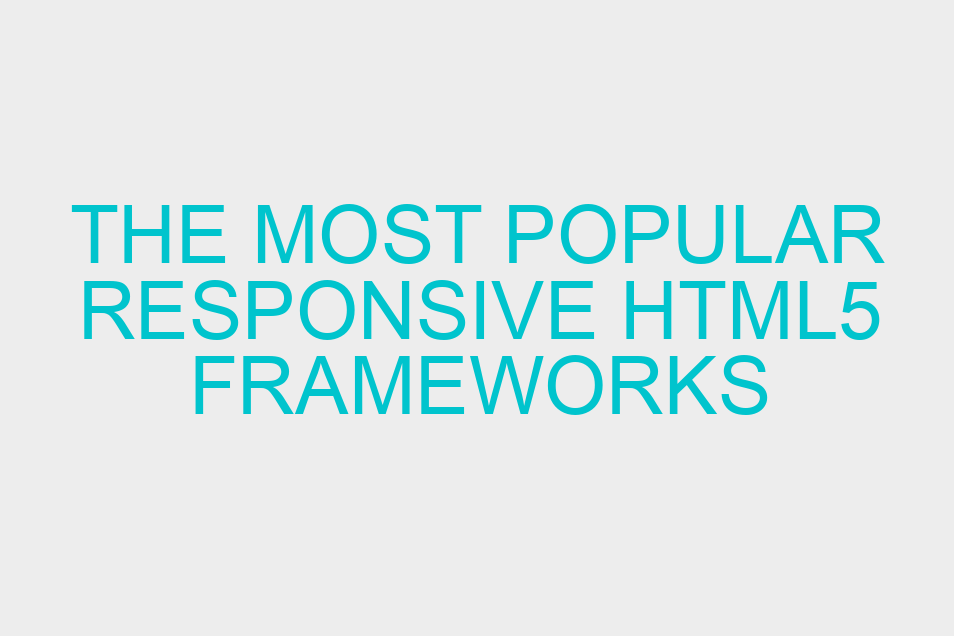The most popular responsive html5 frameworks

As a website designer and developer, I’m obsessed with the latest technology and want to always produce the very best websites for my clients. I know the continued success of Ignition Media will always depend on how hard I strive to make my clients happy. Whether it is the best website design, the best SEO results or the best HTML framework, I’m continually striving to achieve greatness. For this reason, Ignition Media is recognised as one of the leading Gold Coast website design and development companies. When it comes to HTML code, I choose to build all my websites with responsive HTML5 frameworks as I believe that every website should be created with a built in (and complementary) mobile website.
In this article, I intend to discuss the HTML5 frameworks I use here at Ignition Media — Bootstrap and Foundation. But before that, let’s discuss what HTML 5 is first.
HTML 5
HTML5 is the latest HTML standard; a core technology markup language used for presenting and properly structuring content for the Internet. In essence, it defines the fifth major revision of HTML or Hypertext Markup Language. New features include specific functions for embedding interactive documents as well as graphics, video, and audio. It also allows web designers to define sections using new tags, which defines article, navigation links, and media sources.
Ready to Ignite Your Website?
If you are not satisfied with your current website designer or SEO, call me, Nicole Brooke. I’m highly efficient and always available.
HTML5, which has been in used for several years, has the potential of becoming an official industry standard for web development because it a) makes support easier, b) uses semantic elements and c) it allows developers to store data in the user’s browser.
Bootstrap
Now that we’ve discussed what HTML5 is, let’s talk about Bootstrap and why we use it here at Ignition Media.
I love Bootstrap because for one, it is one of the most powerful front-end frameworks and it makes the process of developing a website faster and easier. It’s a free collection of tools containing CSS and HTML-based design templates for components such as text, forms, navigation, and buttons. Bootstrap, which also contains optional JavaScript extension, was developed by the same people behind Twitter and was designed to encourage consistency across internal tools.
In addition, all popular browsers support Bootstrap and it allows me to create responsive websites that can adjust to desktops, mobile phones, and tablets. Considering the growing number of people accessing the internet on the go, this is highly beneficial as it means more traffic to your website.
Foundation
Foundation, just like Bootstrap, is a front-end HTML5 framework that consists of several tools that I find useful when creating a responsive, mobile first website. It uses modern practices and technologies despite the fact that it was primarily built in jQuery, CSS, and HTML.
As a website owner, one must strive to provide online visitors with great user experience. One thing you can do to make this happen is to make sure that your website loads in just a couple of seconds. Foundation helps you achieve this because it’s specifically designed to be faster for users. It also features smoother transitions and animations with hardware acceleration.
Foundation includes a range of functions and features. It has all imaginable HTML elements and it’s built on a percentage-based fluid grid system. In addition, it comes with a lightbox plugin and packaged with jQuery slider. This allows you to create custom forms, re-invent tricky input elements, and easily style checkboxes and dropdowns. Lastly, it offers web designers the option to customise mobile layouts. As a result, you can personalise the website for mobile and desktop users.
Here at Ignition Media, I consider the mobile version to be one of the most important elements in the website creation process. I want to make sure that each website is highly responsive and can be viewed properly on any device, regardless of the size. Building a website in a HTML5 framework such as Bootstrap or Foundation allows you to reach out to more customers and increases the possibility of converting visitors into actual customers.
Conclusion:
If you’re after a responsive website or a mobile website, you should consider using HTML5 frameworks like Bootstrap and Foundation to achieve this. Don’t have the needed skills and expertise? Then let Ignition Media create a state-of-the-art website for you. We have been in this business since 2005 and are proud to say that we have a long list of extremely satisfied customers. If you have questions, feel free to contact me through the contact form.
Related Topics
